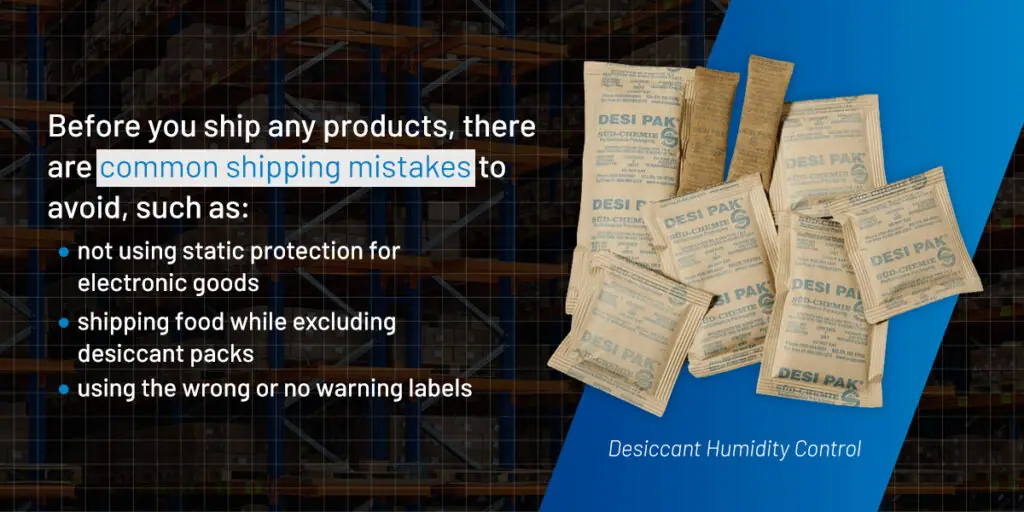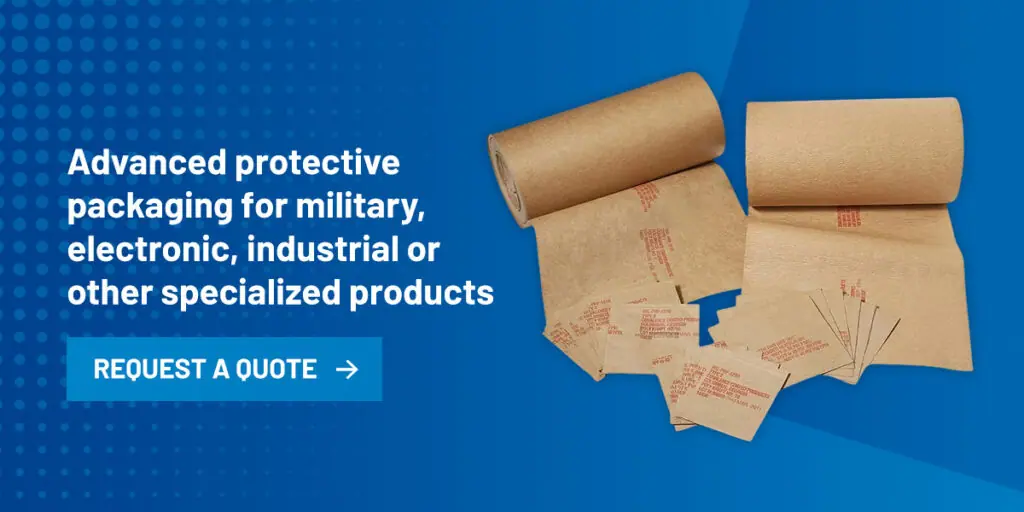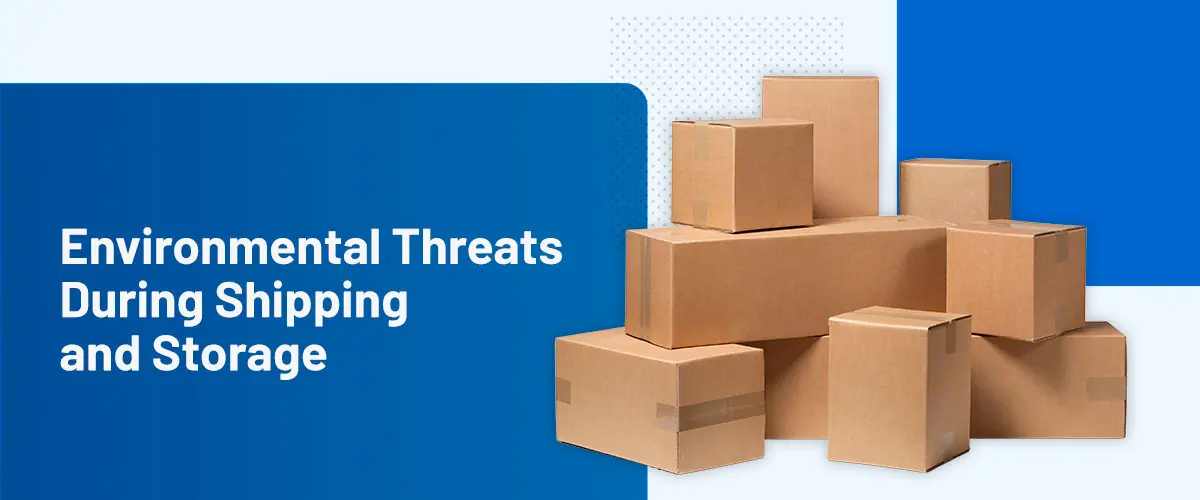If you are a government contractor or require specialized packaging for industrial, electrical or similar sectors, knowing the environmental hazards for packages during shipping and handling is crucial. Your products need protection from moisture, humidity, corrosion and heat. Thankfully, there is a solution to each of these environmental threats.
Learn more about environmental threats and how to mitigate risk by ensuring quality packaging usage and collaborating with knowledgeable suppliers and logistics companies.
Moisture and Humidity
Two critical environmental threats to your packaging and products are moisture and humidity. So, it is a good idea to consider looking over a valuable moisture protection guide and understanding moisture and humidity.
Moisture refers to the presence of water as a liquid or vapor, while humidity is the concentration of water vapor in the air. Both can cause severe damage to packaging and goods if packaging quality control is poor and the packages are not properly managed.
It is essential to know how moisture damages packing and the contents. For instance, the presence of moisture can lead to various forms of damage, including:
- Packaging deterioration: Certain packaging materials can weaken and break down, compromising the package’s integrity.
- Corrosion: Metal containers or products can rust, weakening their structure and reducing their life span.
- Mold and mildew: Organic materials like paper, cardboard, textiles and wood can develop mold and mildew. This leads to spoilage and even health hazards. It is crucial to understand how to avoid mold in your packages in moist and humid conditions.
- Warping: Packaging and products made from wood, cardboard or some plastics can warp, impacting their appearance and usability.
There are also several myths about moisture damage and how to resolve the issue. It’s best to use commercial moisture barrier bags and military specification desiccant packets to curb the potential threat of moisture and humidity.
There are three key facts to know about humidity:
- Humidity occurs even in seemingly dry areas.
- Humidity is not limited to outdoors.
- Humidity can damage almost anything.
When packages are exposed to high humidity, the air inside storage containers or shipping units can hold more water vapor. Once the temperature drops, this vapor can condense into a liquid, which can then fall onto packages and goods, causing water damage.
Therefore, it is highly advisable to attach humidity indicator cards inside or on your packages to make it easy to read whether humidity levels are too high.
Electrostatic Discharge (ESD)
Most agree that moisture and humidity are vital concerns when transporting electronic equipment. It is equally crucial to understand electrostatic discharge, how it can impact packaging and products, and how to protect goods.
Electrostatic discharge (ESD) is an immediate but unintentional flow of electricity between two electrically charged objects and often occurs when they touch. This can lead to an electrical short, which travels along an unintended path with low impedance. Alternatively, a dielectric breakdown can occur when the insulating material fails to prevent the flow of a current due to electrical stress.
ESD is often associated with static electricity and can create a visible spark. For example, if you carry electrical equipment over a carpet, friction causes static electricity to transfer between you and the object.
ESD is a significant concern in the shipping and storing of electrical components and similar sensitive items. It occurs when materials build up an electrostatic charge through items rubbing together, known as tribocharging, and electrostatic induction, where objects are near each other.
The potential threats posed by ESD to products are substantial and include:
- Component damage
- Data loss
- Fire hazard
That is why it is crucial for companies shipping electrical components to use quality static shielding bags, which also act as moisture barriers, allowing you to cover two factors simultaneously.
Logistics
Before you ship any products, there are common shipping mistakes to avoid, such as not using static protection for electronic goods, shipping food while excluding desiccant packs, and using the wrong or no warning labels. These are all factors that you have control over. However, once the product leaves your hands, so does its treatment, which means it must be adequately prepared before shipment.
Damage can occur due to various factors, including human error, mishandling, unanticipated storage delays, or improper storage and transport.
Human error and mishandling are common causes of product and package damage. Workers may drop packages, stack them incorrectly or fail to follow handling instructions. This can lead to physical damage such as dents, scratches or even breakage of fragile items like electronic equipment. Additionally, unanticipated storage delays can expose products to adverse conditions, and improper storage and transport further exacerbate the mentioned risks.
To mitigate these risks, take protective measures such as using effective packaging labels for clear identification and the following measures:
- Use robust, durable and high-quality packaging.
- Include clear instructions in the form of labels and handling instructions.
- Partner with reliable, reputable logistics providers for shipping.
- Acquire shipping insurance to cover potential losses.
- Install tracking and monitoring technologies on your freight.

Corrosion
Corrosion is a gradual breakdown of materials, most commonly affecting metals. It occurs due to chemical reactions with the surrounding environment, such as oxygen, moisture or humidity. The destructive process breaks down refined metals into chemically stable oxides, sulfides or hydroxides. Common examples of this process include silver tarnishing and iron rusting.
During storage and shipping, corrosion poses a significant threat to packages, especially those containing metal components. The factors that can lead to corrosion include exposure to moisture, salt, acids and temperature fluctuations. Corrosion can lead to several issues for metallic products, such as:
- Structural weakness
- Product degradation
- Contamination
To prevent corrosion during storage and shipping, you can take several measures, including using volatile corrosion inhibitor (VCI) protective packaging and implementing the following:
- Add protective coatings to metals
- Include desiccants like silica gel
- Use corrosion-inhibiting packaging
- Incorporate moisture-inhibiting packaging
- Store packages in climate-controlled environments
Sunlight and Heat Damage
Excessive sunlight can cause sun damage to your packages, altering their appearance. Prolonged exposure can whitewash your packages, making labels and important information harder to read. This can lead to incorrect handling and logistics issues.
Heat damage from extreme temperatures can also compromise the packaging and contents. Foods and liquids are particularly vulnerable, as they often spoil quickly under high heat. Products containing paints or plastics can also suffer, with paints fading or peeling and plastics melting or warping.
To mitigate these risks, store packages in shaded, cool, dry, temperature-controlled environments. Use opaque packaging or UV-resistant materials as needed. Proper handling and storage practices can help ensure that products arrive in optimal condition and maintain quality and integrity.
Edco Supply Corporation
At Edco, we are military and protective packaging specialists, and we understand the vast importance of mitigating environmental hazards for packages through proper packaging quality control. Although there are several threats to your packaging and products during shipments and storage, our protective packaging products can shield your goods.
Edco is your solution. Whether you require advanced protective packaging for military, electronic, industrial or other specialized products, contact us today, and we can provide unbeatable turnaround times at competitive pricing.




